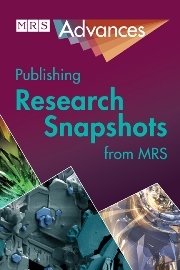Article contents
Review of the Stability/Capacity Trade-off in Silver Hollandite Lithium Battery Cathodes
Published online by Cambridge University Press: 20 March 2018
Abstract
Highly detailed structural characterization is required to understand the discharge mechanism in order to effectively investigate α-MnO2 structured lithium battery cathode materials. This paper discusses recent findings which elucidate the lithiation mechanism of silver-hollandite, AgxMn8O16. For Ag1.2Mn8O16, the structure is not significantly perturbed during the first 2 equivalents of lithiation and the electrochemistry is highly reversible. Upon 4 equivalents of lithiation, the structure becomes highly distorted, in correlation with capacity fade observed over 40 cycles. Notably, regarding capacity fade, modifications to Ag/Mn ratio are less impactful than modifications to the α-MnO2 crystallite size. This is shown in comparisons of two materials with the same stoichiometry (Ag1.4Mn8O16) and differing crystallite size (10 and 15 nm).
Keywords
- Type
- Articles
- Information
- Copyright
- Copyright © Materials Research Society 2018
Footnotes
Equivalent contributions.
References
References:
- 1
- Cited by


